WORKING WITH CORAL HULL ON ZOO
By John Kinsella
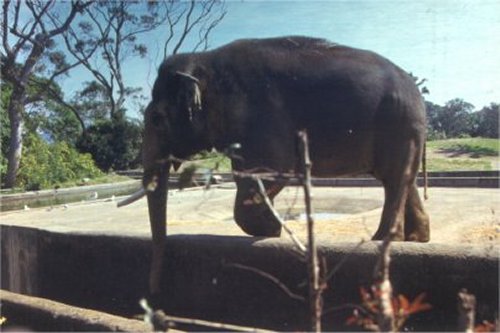
[Above] Defeated Elephant swaying compulsively in small a concrete pen. (Photo by Coral Hull, 1997)
"When I started writing Zoo I just wanted to write about caged animals, to try and describe them as best I could. Although I was engaged in a ZooCheck* with a primarily political motive, I felt that I could achieve a greater depth and intensity by poetic exploration of the subject matter. It is a great task to describe another lifeform with accuracy and compassion. During the creative construction of the book, I was quickly led beyond politics and into a greater sorrow for life on earth, including humanity, the saddest animal of them all. This is seen in poems such as 'The Globe Is Wearing Us Down', 'The Moon Rocket Crashes On Planet Trauma' and 'The Baby Mouse Is Dead'. The basis for my work is a quest for truth and knowledge, and the need to construct and identity from a chaotic universe. I want people to think more about this strange existence. My greatest achievement is where I am able to turn sorrow into joy - to transform. I admire the strength of the superheroes, and feel that it is only morally correct to pull out words like swords, rather than write a witty poem about a paper clip." - Coral Hull
Before starting the Zoo project with Coral Hull I'd known her work for almost a decade - first seeing it in literary journals and at Salt, and later in writing on William's Mongrels for the Australian's Review of books. Hull's exploration of landscape and concern for ethical issues were strong attractions for me. I use the word 'explorations' in a heightened sense here, as it is the negative aspect of human colonization and occupation of a place that she so strongly writes against. A visual poet, she makes her observations in an ethical framework that qualifies the way we see and the potential ramifications of this seeing.
It makes sense that Hull is also a photographer and and artist, that there is a synthesis between words on the page and other forms of illumination. Hull's landscapes are also of the body and the unconscious - the exploration of the land and the exploitation of the body and soul, almost a visually exploding ecriture feminin, are intricately linked. Hers are poems in which conspiracy is actualized - they reject the politics of imposition and invasiveness. They are about the rights of the individual, of collective consciousness, of animals, of place, of different cultures. Read by some as purely emotional reactions, they are often rather logical, calculated responses to oppression, infused with a 'passion' that makes the target 'see red'. Hers is political poetry that at its best transcends the polemical. Infused with extended metaphor and a strong sense of metonymic build-up, the poems take things head-on both artistically and rhetorically.
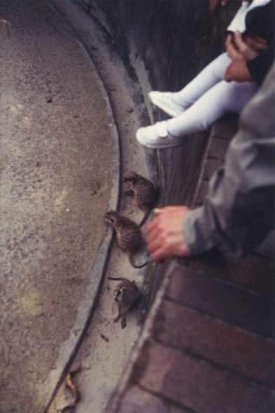
|
A couple of years ago, when I was visiting Sydney, I met with Hull who was going over to Taronga Park Zoo to do a ZooCheck. She asked me to accompany her. After much deliberation - zoos to me are concentration camps (as they are to Hull), not places of preservation - I decided to go with her and to help with her report. Both of us ended up angry and disgusted at what we found. Our collaborative book Zoo, due for publication this year with Paperbark/Craftsman House, comes directly out of that experience. The title does not refer purely to the Taronga visit, but to human interaction with animals in general. It's the process of collaboration, and the ethical issues confronted by this work, especially as they reflect on Hull's work as a whole, that I wish to discuss.
The question of whether the process of writing poetry is more important than its ethical basis, or the subject matter that inspires and drives it, is fundamental to understanding the 'poetics' or modus operandi of Hull. Hull's prime concern is animal rights and the well-being of animals in general. Like myself, she is a committed vegan. |
[Above] Meerkats being fed zoo cafe junk food in a concrete pit. (Photo by Coral Hull, 1997)
She functions as an advocate for animals - a go-between for the generally insensitive and exploitative world of humans and the multiple worlds of animal life. And she is a 'doer' - a direct-action person heavily involved in Animal Rights activities, both in the tradition of the 'pamphleteer' and as 'field operative'. Which is not to say she is unconcerned with specifically human issues. The nature of recollection and memory, of family, of the destructive nature of patriarchy, and all forms of oppression, come constantly under scrutiny in poems such as 'Praying Mantis', 'Sharpies', and 'Liverpool' - all from William's Mongrels.
Hull can approach such things through prose, photography, and other media with as much enthusiasm and determination. But in the end, it is the ability to create conceits, to distil the moment and enrich through metaphor, that makes all her art poetic at its core. It's not so much a case of the 'perfect words in the perfect order', but of layers of sensibilities simultaneously interacting. Romantic claims to vocation and talent are convenient and mostly class-driven. Writing out of a 'working-class' ethos as conscious construct, Hull takes 'inspiration' and enhances it with necessity, even expediency. One writes because one has an obligation to do so. Even at her most 'confessional', she works solidly against the notion of the 'confessional poet'. The self and personal experience may be a focus of observation, but they are always vehicles to some 'greater' political end. Hull doesn't ditch herself, but uses herself as a mouthpiece for the unspoken and often the unspeakable.
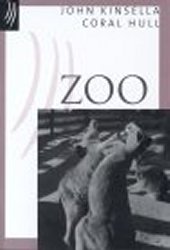
|
Her process is about using the tools at hand, the most appropriate device for translating - the self. She sees the poet as having a genuine role in 'society' - making a firm contribution to the physical and spiritual well-being of the individual and the collective. For Hull, poetry is a powerful tool for highlighting, and potentially righting, multiple wrongs. This politicization may have placed her outside usual funding environments; she has struggled for many years without the support that many ostensibly apolitical poets of equal critical stature have found more readily available.
So poetry and politics are inseparable for Hull. And this is another thing we agree on. In Zoo, the majority of Hull's pieces are 'direct action' in nature; most of mine work by allusion and circumlocution. I think this is what makes the collaboration function as a book. Where Hull will say something outright and then build layers of metaphorical allusion, I'll start with the metaphoric allusion and leave the reader to distil the politics. |
[Above] Zoo Cover (Photo by Juno Gemes, year unknown)
Of course, there are exceptions on both sides, but this is a general principle. Also, Hull's pieces in Zoo tend to be prose poems in the main, while mine tend to be lyrical - if at times, experimental 'anti-lyrics'. We both, however, agree that genre is there to be crossed, and really the realms of prose and poetry, words and paintings, sound and sight, are indivisible. The very act of collaboration is a political one, in the willingness to break the boundaries between one's own personal territory and that of another, to take this then into the public arena. Even when the poems in Zoo focus most on 'the self', it is in the sense that this 'self' is part of a public consciousness, that it is concerned with universal issues. The poetic voice made 'ethical'.
Over the last few years I have been involved with a number of collaborations - from text-based book length structures based on the works of Deleuze and Guattari with the Swiss poet-sculptor Urs Jaeggi, through to e-mail collaborations with the American poet Susan Schultz, the Australian Louis Armand, and the British avant-gardist Keston Sutherland. I have also collaborated on a quasi-narrative poem with John Tranter and a variety of projects - primarily based on responses to paintings - with Tracy Ryan. Most recently the volume and cd The Kangaroo Virus Project, with sound artist and photographer Ron Sims, has been published. Different from most of these, but sharing some features with The Kangaroo Virus Project, Zoo covers not only textual ground but entire worldviews. It has been as much an ethical collaboration as an artistic one - though as the book attempts to demonstrate, such divisions are false anyway.
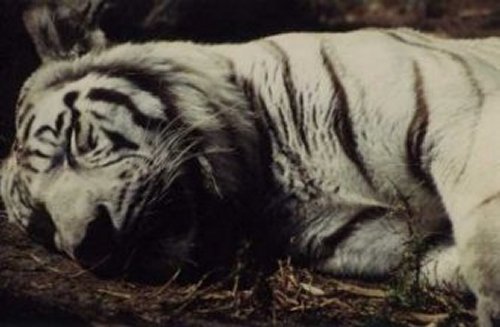
[Above] Chronically bored tiger asleep in window-lined box. (Photos by Coral Hull, 1997)
The methodologies of a Hull poem and a Kinsella poem have some things in common. There is an accumulation of data, a series of moral/ethical references that move in and out of the text, an interplay - or meta-textual play - with the readers'/audience's expectations. The fundamental differences relate to the use of formal poetic devices, the build-up of an internal referentiality in my poems as opposed to Hull's more externalized references, and the idea that I pursue: that language can be an end in itself. Of course these are issues that arise in Hull's poetry, but there is always a specific emotional and consequently socio-political response looked for in the presentation of a Hull poem. Hull will deplay devices that lure, arrest, and eventually make the reader complicit in order to get the message across - such as conflating a child with an animal in order to stimulate a response of disgust, which is then skilfully transferred onto the object of sympathy. Persona and rhetoric are deftly manipulated to keep the reader compelled, to prevent alienation from the speaker. This is how guilt and complicity are evoked. Then a series of mnemonic triggers provides a familiar framework for the reader to position response - an incident, sight, smell, or emotion from childhood, the recollection of a story, and so on. Infused with a strong sense of visualization - of painting - the reader is moved to respond. An atmosphere of verisimilitude is created.
Hull's previous book, Broken Land - 5 Days in Bre 1995, is a brilliant example of this cumulative process - a photo essay, a documentary, a series of visual and emotional responses, an ethical and political manifesto, a deconstructed picaresque that confronts the spectre of death. The 'river' of this land-bound picaresque is the flow of blood from the slaughter of kangaroos, the slaughter of all animals by the machine of human exploitation.
The following poem by Hull from Zoo illustrates part of this cumulative process at work:
A broken down train is reclaiming the same tunnel on a circular track. Now confronted with this living red miracle, I was intent upon making contact. Yet the red fox would have none of it. All the tantrums of my small plump legs, couldn't get that fox to stop and look. Mission had turned to obsession, down the long highway of hysteria. Her eyes shone like rich liquor, unfocused and timeless, captured like an insect in amber. Her fiery tail like a stubbed cigarette. There was no reaching into her, fingers on the wire, my chubby knees pinned to the dirt, the soft skin stapled by twigs and stones. I knew that something was very wrong here, yet I trusted the world. "Foxes are beautiful," I said.
I suddenly felt her full of pain and worry. Nan thought the bears had frightened me, those zoochotic polar bears that swayed deep inside the concrete pits. Once my brother dropped his plastic bottle, and crawled through a barricade in his nappy to get it. The polar bear's eyes were already on the toddler that teetered on the edge. For a moment I felt the silence of nightmares that emit strained and desperate cries. This was the world of the captive bears a long way from the icefloes and Churchill. The animals were teaching me lessons. It was like a shadow crept into my heart to settle there. "This is the world," it said, "welcome little girl who learns from everything"." ('Fox In A Cage At The Zoo')
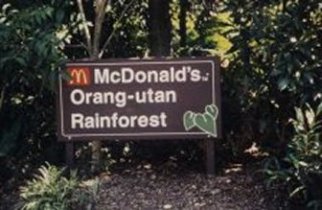 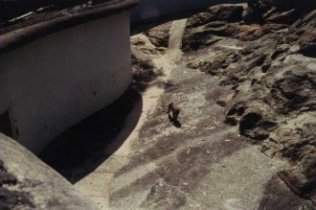
[Above Left] A box with several plants for orang-utans from McDonalds. (Photo by Coral Hull, 1997) [Above Right] A solitary primate in a concrete pit. (Photo by Coral Hull, 1997)
A more rhetorical though equally forceful piece by Hull from Zoo is the poem in which she replaces 'cow' with 'child':
I am going to replace the subject of 'cow' with 'child,' in order to reply to your statement/question that: 'it's better to wear the skin off a dead child than to go and kill a child yourself'. First of all, being a childrens' rights activist, this statement is offensive to me. Why? Because I think that the use of the word 'better' somehow condones the former. But aside from my gut response, I will elaborate on why I think that wearing the skin of a dead child is not a good tactic for childrens' rights. 1) The child is dead and has been murdered and you participated in the murder. (From a childrens' rights perspective, to wear the skin of a murdered child that you participated in murdering, whether that child is part of your family or someone elses, is unacceptable) 2) The child is dead and has been murdered by others and you did not participate. (From a childrens' rights perspective, to wear the skin of a murdered child is unacceptable even if someone else did the murdering) 3) The child is dead and has been found by you in a paddock and you don't know whether s/he has been murdered or not. (From a childrens' rights perspective, to wear the skin of a dead child is unacceptable, because you cannot be sure in a society that openly promotes the genocide of children, if that child has been tortured and murdered) 4) The child is dead and you have seen that child die, so you know that s/he hasn't been murdered. (From a childrens' rights perspective, to wear the skin of a dead child is unacceptable, because you cannot be sure in a society that openly promotes the torturing and genocide of children, what kind of life that child has had or if that child has been tortured. Also if you saw the child dying, I would expect that you might have tried to save his/her life) 5) The child is dead. S/he is your own child, and you know that s/he has had a good life and s/he died quite peacefully in his/her sleep. (From a childrens' rights perspective, to wear the skin of a dead child is still unacceptable in a society that openly promotes the torturing and genocide of children, because to do so, means that you will be advertising the skin to others who might like the look of it, and who might either support or participate, in the murdering or torturing of another child to have skin like yours. None of the above promotes childrens' rights, therefore they are all unacceptable from a childrens' rights perspective. ('November 3rd, 1997, Murder Scenario')
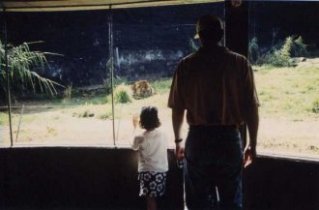 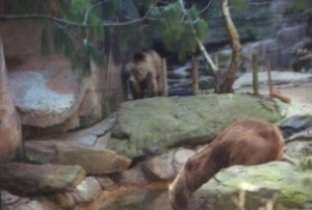
[Above Left] Chronically bored tiger (No.2) asleep in a window-lined box. (Photo by Coral Hull, 1997) [Above Right] Chronically bored grizzly bears swaying compulsively and asleep in a window-lined box. (Photo by Coral Hull, 1997)
In the Zoo collaboration, we are poets responding sometimes to each other, sometimes to an ethical concern or specific event, sometimes to a general principle, but most often the poems are parallel evolving texts quite independent of each other. Many of these poems couldn't have been written without the interactions, but others would have been, and indeed were. Which made the process fascinating. The book, the end result was the 'collaboration'. The order of texts is all-important. There is no indication of who wrote what, but it is easy to pick up individual voices and stylistic differences. These are 'universal' voices moving in through, with, and on occasion against each other. Hull and I have different views on how much the reader/audience can take directly - I generally feel allusion and a residual effect evoke a greater response. But generally, we exist in each other's poem, and conflate, collude, and work as a chorus line. My digressions are mainly to do with experimentation, such as in the 'Echidna poems', but in the end, the concern is universal.
Which brings me back to Taronga Park. The whole business of arriving by ferry, being hauled over the circles of inferno by cable car, and being confronted by icecream and confectionary shops set the stage. And a stage it was - animals in their cages and glass boxes, the absurd sideshow called the nocturnal house, an elephant with a genital growth, performing seals, the psychologically-wrecked apes, and so on. Coral's ZooCheck report was damning, to put it mildly. I couldn't cope and didn't know why I was there - I felt lurid, like a voyeur of the most damaging kind. To give some meaning to it all, we proposed writing a book about the experience.
Thus Zoo. Coral was at Taronga for investigative purposes, to report on the conditions and help work towards an improvement in the animals' lot. I was there to make myself aware of what I codemn i word, what I once condemn in direct protest, but now have filed away in a series of references in my writing. Zoo is an attempt to redress this - to make active my protest, to frame it in such a way that there can be no equivocation about the ethical concerns at stake. But by working with Hull's more direct voice, I am enabled still to explore the poetic and linguistic concerns that have so dominated my project in recent years. I genuinely believe that it is ethically responsible to explore what it is that constitutes language, that by freeing explication, by investigating its inner workings, one can move closer to a truth. Here is one of my poems from the collaboration:
Each cell a pixel screened in the upper register;
what impresses the human ear but silence or the quarter-
tone of the condensed mental cycle, the psychic expedition,
those passing-the-time tricks we know prisoners
have at their fingertips? The bird's a fucking astral
traveller I reckon! Can't ya tell? Standing there
with your chips & Fanta ... those birds'-nest soup swiftlets
- Collocalia - echo locating a way out as the whole zoo
bristles like quadrophenia: cheetah, chicken, chimpanzee,
coatimundi, cockatoo, CONDOR: icon, soarer rip-roaring
thermals over kodachrome Andes from Venezuela
to Tierra del Fuego & back again. ('The Virtual Zoo')
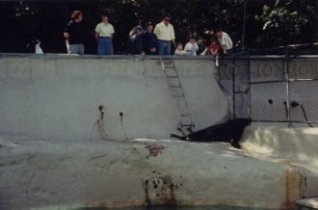 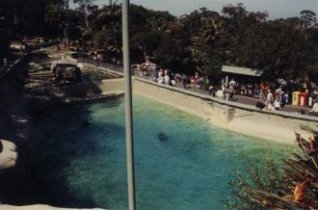
[Above Left] Defeated sea lion in fibreglass and concrete pit. (Photo by Coral Hull, 1997) [Above Right] Chronically bored sea lion aimlessly swimming the length of the fibre glass and concrete pit. (Photo by Coral Hull, 1997)
And part of Hull's 'Taronga Park Zoo In Sydney':
I will not forgive the zoo for the elephant, for his far-fetched torment. His lengthy sway in every waking moment and when he slept, thrown sideways like simulated waves inside the sea lion tank. A whiff of ocean from the harbour persisted and grew strong, as the ferries glided further and further away, whilst captive marine mammals circled in parallel swimming pools. At every cage John said, "that's the worst". It got worse as the day grew longer. I knew that he would not forgive them for the Andes Condor. "It's a bird that SOARS in high altitudes!" he said, words rising up inside his throat. The choke of tethered emotions, and the damp finality of wings that would never meet clouds. A tremendous lonesome bird sat hunched behind layers of mesh and pipes, a wire cage six foot above its head. Taronga Park Zoo flattened the Andes. They made that condor crawl.
One aspect of Hull's work that fascinates me is her ability to make the familiar dangerous, to take the complacency implicit in our interaction and generation of popular culture and render it confronting. As we sit back and laugh at ourselves disfigured into our negative character components on television, while safely distancing ourselves at the same time, we avoid the issue. In her poem 'The Zoo Ark' Hull repeats the line "Oh my god, they've killed Kenny" like a mantra:
A black bear with a sugar addiction is a large problem.
Scientists found it exciting but worrisome.
"Oh my god, they've killed Kenny!"
If you could actually feel their misery.
A short sound bite from the continual flow of the television, the zoo. The uneasy laughter that comes with a splatter scene from "South Park".
In looking for the influences of other poets on the construction of Zoo, one might look in all the obvious places - landscape poetry, the pastoral tradition, polemical verse, and so on - or nowhere at all. The influences on the text may be manifold - from Judith Wright to Jacques Derrida, Les Murray to Peter Singer, Marrianne Moore to J.H.Prynne, Robert Adamson to Pablo Neruda, but as a book it has arisen out of an ethical concern and its origin is in debate investigation, and revolution. There are myriad other concerns subtextually explored - questions of gender identity, institutionalization, isolation, racism, and bigotry in general. In many ways its catchcry is Liberty, Equality, and Fraternity - but for all living creatures!
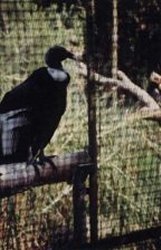
|
Hull's work strikes me as having much in common with Blake's - an element of faux-naif of the best kind, a sense of the visionary, and a framework of moral investigation fused together in a voice that is at once hermetic and public. On the completion of Zoo, I look at the book as a kind of illuminated manuscript - sometimes with texts by Hull, 'engravings' by me, and at other times vice versa. Hull's is a voice in which Heaven and Hell are in constant struggle, and there is a sense of contrariness. My boundaries are more blurred than this, but both of us see it as necessary to break down boundaries for some kind of truth to be envisioned. But for Hull there is a right and a wrong world, and in this she is an optimist. Zoo is a positive book - or, at least, a book in which the hope that wrongs can be made right is strongly expressed. For me the bird is the symbol of hope, as it is for Hull; as are all animals. For both of us, humans are the phantom limb of all animals, as they are for us. |
[Above] Defeated Andes Condor perched alone in tiny cage. (Photo by Coral Hull, 1997)
One of the invigorating aspects of the project was the diversity of styles. As mentioned, Hull makes most use of the prose poem in block format, while I concentrated basically on the short-line lyric. But there are lyrical pieces by Hull, and a range of line length and stanza patterns from myself. But in the end, the subject matter dictates the form. And though writing of animals and zoos, we are not, as Hull points put, 'Zoo Poets'!
But this is not a zoo poem.
It sounds like a complaint.
It sounds more like,
I want to spoil all the fun.
I am not a zoo poet.
Eds Note: * ZooCheck is an investigative action taken by animal rights advocates to expose stereotypical behaviour, such as swaying and pacing amongst other things that occur in imprisoned animals, to give evidence of unnatural behaviour in unnatural habitats via written and photographic documentation.
Published in Overland (Australia)
About the Writer John Kinsella
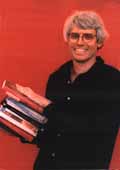
|
John Kinsella is the author of more than twenty books whose many prizes and awards include a Young Australian Creative Fellowship from the former PM of Australia, Paul Keating, and senior Fellowships from the Literature Board of The Australia Council. He is the editor of the international literary journal Salt. He was appointed the Richard L Thomas Professor of Creative Writing at Kenyon College in the United States for 2001, and where he is now Professor of English. He is a Fellow of Churchill College, Cambridge University, and Adjunct Professor to Edith Cowan University, Western Australia. His selected poems and selected essays are forthcoming, as well as a new novel Post-Colonial and a book of short stories (co-authored with Tracy Ryan). John Kinsella is now the poetry critic for the Observer newspaper (London). |
[Above] Photo of John Kinsella by Wendy Kinsella, 1996
I Next I
Back I
Exit I
Thylazine No.3 (March, 2001) |



